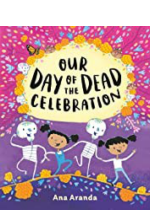
A family honors their living and dead relatives as they celebrate this holiday with shared food and stories.

A family honors their living and dead relatives as they celebrate this holiday with shared food and stories.
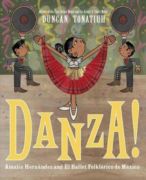
Award-winning author and illustrator Duncan Tonatiuh tells the story of Amalia Hernandez, dancer and founder of El Ballet Folklorico de Mexico. Published in time for the 100th anniversary of Hernandez’s birth, Danza! is the first picture book about the famous dancer and choreographer. Danza! is a celebration of Hernandez’s life and of the rich history of dance in Mexico. As a child, Amalia always thought she would grow up to be a teacher, until she saw a performance of dancers in her town square. She was fascinated by the way the dancers twirled and swayed, and she knew that someday she would be a dancer, too. She began to study many different types of dance, including ballet and modern, under some of the best teachers in the world. Hernandez traveled throughout Mexico studying and learning regional dances. Soon she founded her own dance company, El Ballet Folklorico de Mexico, where she integrated her knowledge of ballet and modern dance with folkloric dances. The group began to perform all over the country and soon all over the world, becoming an international sensation that still tours today. Duncan Tonatiuh’s picture books have been honored with many awards and accolades, including the Pura Belpre Award, the Robert F. Sibert Award, and the New York Times Best Illustrated Book Award. With Tonatiuh’s distinctive Mixtec-inspired artwork and colorful drawings that seem to leap off the page, Danza! will enthrall and inspire young readers with the fascinating story of this important dancer and choreographer.
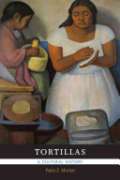
“The ordinary tortilla was an extraordinary bond between the human and divine. . . . From birthdays to religious ceremonies, the people of Mesoamerica commemorated important events with tortillas. One Maya tribe even buried their dead with tortillas so that the dogs eaten as dinner during life would not bite the deceased in revenge.”–from Tortillas: A Cultural History For centuries tortillas have remained a staple of the Mexican diet, but the rich significance of this unleavened flatbread stretches far beyond food. Today the tortilla crosses cultures and borders as part of an international network of people, customs, and culinary traditions. In this entertaining and informative account Paula E. Morton surveys the history of the tortilla from its roots in ancient Mesoamerica to the cross-cultural global tortilla. Morton tells the story of tortillas and the people who make and eat them–from the Mexican woman rolling the mano over the metate to grind corn, to the enormous wheat tortillas made in northern Mexico, to twenty-first-century elaborations like the stuffed burrito. This study–the first to extensively present the tortilla’s history, symbolism, and impact–shows how the tortilla has changed our understanding of home cooking, industrialized food, healthy cuisine, and the people who live across borders.
Explores the different colors found in Mexico’s nature and history.
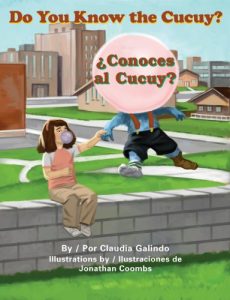 “The Cucuy is a tall, furry, three-eyed, four-armed monster with a mouth full of huge teeth,” Papo tells his granddaughter. And, he warns, if she doesn’t behave, the Cucuy will take her away! She used to be afraid of the Cucuy, until one day she meets him and learns that he is not the frightful beast her grandfather described. Instead, he’s cute and likes to play. His fur is blue, and his teeth are small. He may not be just like her, but he does have two arms and two eyes. And the Cucuy also likes to play catch, blow bubbles, and eat candy. Best of all, though, the young girl learns that he doesn’t kidnap naughty children! First-time children’s book author Claudia Galindo and illustrator Jonathan Coombs vividly bring to life a character known to generations of Latino children. Although this time, the Cucuy isn’t a scary monster but instead is a fun playmate.
“The Cucuy is a tall, furry, three-eyed, four-armed monster with a mouth full of huge teeth,” Papo tells his granddaughter. And, he warns, if she doesn’t behave, the Cucuy will take her away! She used to be afraid of the Cucuy, until one day she meets him and learns that he is not the frightful beast her grandfather described. Instead, he’s cute and likes to play. His fur is blue, and his teeth are small. He may not be just like her, but he does have two arms and two eyes. And the Cucuy also likes to play catch, blow bubbles, and eat candy. Best of all, though, the young girl learns that he doesn’t kidnap naughty children! First-time children’s book author Claudia Galindo and illustrator Jonathan Coombs vividly bring to life a character known to generations of Latino children. Although this time, the Cucuy isn’t a scary monster but instead is a fun playmate.
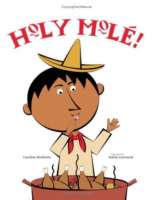
When the Spanish viceroy comes for an unscheduled visit to the monastery, the cook goes into a frenzy. What will they feed this important ambassador to the king? Carlos, the orphan boy who works in the kitchen, tries to stay out of the way as lunch is hastily prepared, but his curiosity gets the best of him. His eagerness results in a moment of crisis, followed by what Brother Roberto can only assume is a miracle. This story, inspired by the Mexican folk tradition, explains the origins of mole, the popular national dish that combines chocolate with turkey, spices, and nuts.
This colorful picture book makes Mexico’s history, geography, food, art, festivals, and sports accessible to young readers.